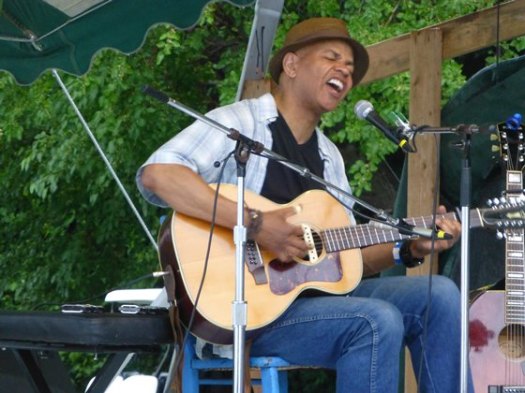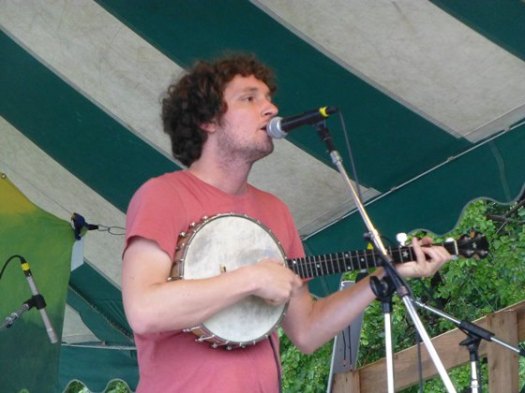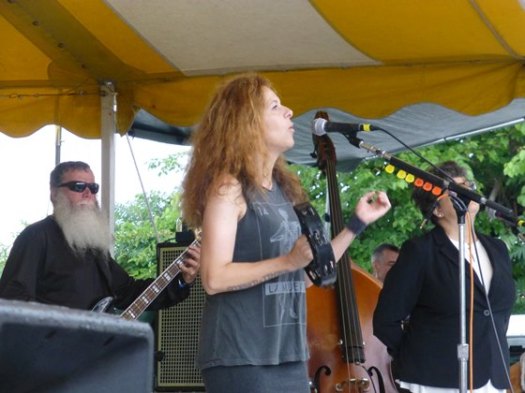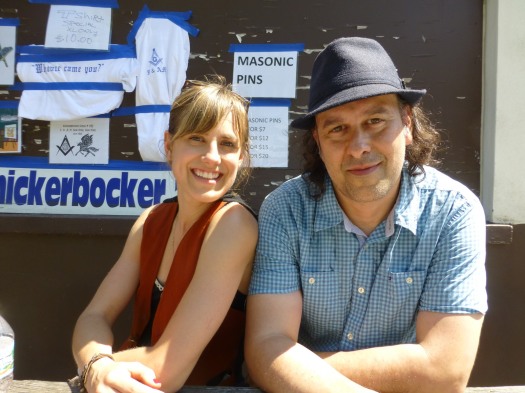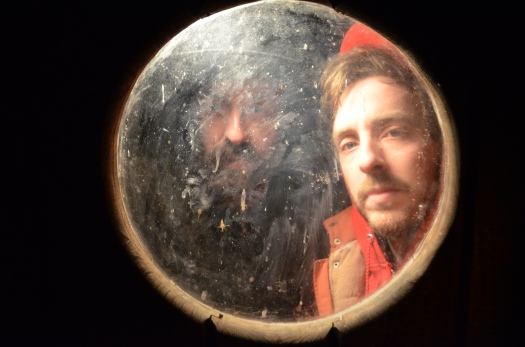Musical tradition is alive and well at the Clearwater Festival, the second without founders Pete or Toshi Seeger. That’s good, but what’s even better is that the tradition isn’t stagnant, it’s growing and evolving, just as it’s already done.
I’m no fan of folk purists, who blanch at the sight of an electric guitar or a plug-in keyboard. For years, the only electric bass at some festivals I attended was employed by the zydeco musicians because, well, zydeco doesn’t work without electricity. Clearwater today has an open-ears booking policy, and that’s why you see younger people among the many tie-died, ponytailed greybeards who show up, even on soggy weekends like this one was.
Dom Flemons, late of the Carolina Chocolate Drops, is known for unearthing the hidden history of the black string bands, but on his latest album he’s branching out stylistically into R&B, country (a Roy Acuff song!) and more, as well as original songs like the celebration of east Nashville cuisine that is “Hot Chicken.” Flemons brought a trio to Clearwater’s Hudson Stage on Saturday, with Brian Farrow on bass and fiddle, and Dante Pope on drums.
Dom’s booming, theatrical voice has brought a lot of old 78s to life–who knew that “Polly Put the Kettle On” was a cool song with English roots? But these days he’s after bigger game.
You could say much the same for Guy Davis, whose big, rich baritone, paired with fluent guitar and a wailing harp, provide him all the tools he needs to recreate bluesmen like Robert Johnson (who he once played onstage). But Davis, who had to fight off rainstorms as Flemons did, is similarly painting with a broader palette these days. The original “Kokomo Kidd” is about white bootleggers using black bagmen during Prohibition, but it moves on to document political payoffs in the present day.
Sam Amidon has no limits as a musician, and boy does he tell funny (and surreal) stories. He’s steeped in the tradition—as the son of traveling folk musicians, he haunted these same grounds as a kid—and became a prodigy fiddle champion, but what he’s doing these days is a unique blend of public domain songs and modern electronica, as in a “Walking Boss” with a steady funk rhythm from the brilliant keyboard man Thomas Bartlett, a childhood friend. Banjo and beats made an unlikely but happy marriage. Check out Amidon’s latest album, recorded with jazz guitarist Bill Frisell in (somehow appropriate for bedrock American songs) Iceland.
Amidon is evolving into a showman. During a keyboard interlude he jumped off the stage and gave us 24 pushups, and a solo showcase for fiddle featured squawkings that the late Ornette Coleman would probably reject as too out there. The set included a song Amidon said he’d “heard on country radio a few days ago,” but he made it his own. Anything could happen, and did.
The same could not be said of a set by CS&N’s David Crosby. Looking healthy and in fine voice as a solo musician, Crosby nonetheless stuck to a set that—at least in the part I heard—never ventured past the early ‘70s. He must perform “Guinnivere,” “Déjà Vu” and “Cowboy Movie” in his sleep. He also revisited old love with a passable version of Joni Mitchell’s “For Free” (never mind that he’s been slagging her off in the press lately).
Crosby lives in the past; Neil Young celebrates today, and that explains their relative popularity.
Joseph Arthur was also solo, but just standing there with a guitar didn’t make him a folkie. Arthur is always adventurous with found sounds on his album, and at Clearwater he looked sleepy and disheveled but nonetheless turned in a fine set with colors from effects pedals and sampling. “The Ballad of Boogie Christ” sure got them listening. And the Talking Heads’ “Naïve Melody” was a good cover choice, especially since I’d also heard it covered by Shawn Colvin in the car on the way up.
And two thumbs up for Mike + Ruthy. They’re Clearwater royalty, having performed in the Mammals with Pete’s grandson, Tao Rodriguez Seeger. And Ruthy is, of course, the daughter of stage mainstay Jay Ungar and folk singer Lyn Hardy. But their set was anything but traditional. The highlight of the new album Bright as You Can is Mike’s song “Rock On Little Jane,” and the performance at Clearwater retained the soulful horn section that appears on the album. And Ruthy really belted that song out, with the video proof right here:
I’ve always wanted to see Shelby Lynne, but she phoned in sick. A reshuffled Los Lobos was just great, showing an unexpected talent for playing not only their own songs but some well-chosen classic rock—“Rattlesnake Shake” by Peter Green-era Fleetwood Mac, “40,000 Headmen” by Traffic and “Bertha” by the Grateful Dead. Did they end with “La Bamba”? You bet, but it worked.
Folk festivals are also great places to make unexpected discoveries, and mine at Clearwater was a young band from south Jersey called Thomas Wesley Stern. They played not any of the festival’s five stages but in some kind of natural foods tent. I loved their version of “Cumberland Gap,” which they correctly pointed out dates to the Civil War. It’s a pretty big band, with twin fiddles and not one but three strong singers who excel at close harmonies.
The self-released Never Leaving is a strong debut album. I was worried when I saw it was all originals—weak material is the bane of a lot of new bands—but I should have had more faith. The album is strong from first note to last.
African singer Angelique Kidjo (she’s from Benin) was also a great Clearwater addition. An internationalist who’s covered a lot of stylistic ground as a solo artist, her tree-trunk-strong voice anchors everything. At Clearwater she gave us a rootsy show, with highlife guitar and plentiful percussion keeping her rocking.
I actually didn’t hear anything bad in a full day of listening, and that’s high praise. Neko Case was in good spirits and that classic country voice of hers pierced the clouds. If I could offer her a brief bit of advice, though, it would be to spice things up a bit. She performed only original songs in the same mid-tempo, and some of them didn’t stick in the mind. It was good to see a favorite singer, Kelly Hogan, backing her up.
Kate Pierson, also singing well, could use some stronger material, too. The Chapin Sisters harmonized exuberantly, and I loved the Everly Brothers songs—but maybe a few deeper tracks than just the big Top 40 hits? I’m sure there was great stuff I missed, and not mentioning it here probably just means I didn’t see it.
But this a strong day of festival music, thanks to an adventurous booking policy. I didn’t camp, but I’m a happy camper, anyway.



